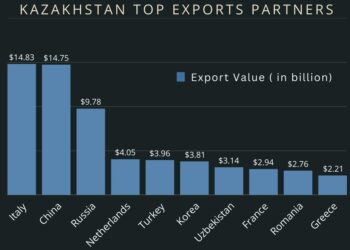Kazakhstan has recorded a significant decline in emigration during the first four months of 2025, according to data released by the country’s migration authorities. Between January and April, the number of citizens leaving the nation reached a new low, signaling a potential shift in migration trends. Experts attribute this decrease to a combination of improved domestic economic conditions and evolving regional dynamics. This article examines the latest figures, explores the factors contributing to the downturn, and considers what it means for Kazakhstan’s demographic and socio-economic landscape.
Kazakhstan’s Emigration Declines Sharply in Early 2025 Driven by Economic Stability
Data released by the Ministry of National Economy indicate a significant drop in the number of citizens leaving Kazakhstan during the first four months of 2025. Experts attribute this decline primarily to improved economic conditions that have bolstered job opportunities and wage growth across multiple sectors. Additionally, government initiatives aimed at enhancing social welfare and investing in infrastructure have contributed to a growing sense of optimism among residents, resulting in fewer people seeking employment or residence abroad.
Key factors influencing the trend include:
- Rising employment rates: Unemployment has decreased by 2.3% compared to the same period last year.
- Increased foreign investment: New capital inflows have stimulated economic activity, particularly in manufacturing and technology.
- Policy reforms: Simplified visa and residency policies have encouraged skilled workers to remain in the country.
- Enhanced quality of life: Improvements in healthcare and education services have made staying more attractive.
| Month | Emigration Cases | % Change YoY |
|---|---|---|
| January 2025 | 4,200 | -18.5% |
| February 2025 | 3,950 | -20.1% |
| March 2025 | 4,100 | -15.7% |
| April 2025 | 3,850 | -22.9% |
Factors Behind Reduced Outflow Highlight Improved Domestic Opportunities and Policy Measures
Kazakhstan’s declining emigration figures in early 2025 reflect a significant shift in the country’s socioeconomic landscape. Increased domestic opportunities, driven by government initiatives to boost local industries and entrepreneurship, have played a pivotal role in retaining citizens. The expansion of job markets in sectors such as technology, manufacturing, and agriculture has created more attractive career paths at home. Additionally, improvements in social infrastructure, including healthcare and education, have enhanced the overall quality of life, encouraging many to stay rather than seek prospects abroad.
Meanwhile, targeted policy measures have further strengthened this trend. Recent reforms aimed at simplifying business registration, coupled with incentives for foreign investment, have invigorated economic growth across regions. Moreover, the government’s efforts to increase salaries in public service and improve labor conditions have made domestic employment more appealing. Key factors contributing to reduced outflow include:
- Enhanced support for small and medium enterprises (SMEs)
- New vocational training programs aligned with market demands
- Streamlined migration and residency policies favoring returnees
- Targeted social welfare improvements in rural and urban areas
| Factor | Impact on Emigration |
|---|---|
| Job Market Expansion | Higher retention rates in key sectors |
| Policy Incentives | Increased entrepreneurship and local investments |
| Social Benefits | Improved living standards reduce migration drive |
Experts Recommend Strengthening Job Creation and Social Programs to Sustain Positive Migration Trends
Experts emphasize that maintaining and enhancing the current downward trend in emigration requires a multifaceted approach focused on economic opportunities and social welfare. Key recommendations include:
- Expanding job creation initiatives to absorb the growing labor force and reduce unemployment pressures.
- Investing in vocational training and skill development to ensure that the workforce meets evolving market demands.
- Strengthening social protections including health care, housing support, and family assistance programs.
According to migration analysts, these measures not only provide immediate relief to potential emigrants but also contribute to long-term national stability by enhancing citizens’ quality of life. Sustainably reducing the factors that drive emigration hinges on balancing economic growth with inclusive social policies, encouraging more people to build their futures within the country.
| Key Area | Current Focus | Recommended Actions |
|---|---|---|
| Employment | Moderate job growth in urban centers | Boost rural job creation and support small businesses |
| Education | Basic vocational programs available | Expand professional skills training and digital literacy |
| Social Programs | Limited family support benefits | Enhance healthcare subsidies and housing assistance |
To Wrap It Up
As Kazakhstan records its lowest emigration figures in the first four months of 2025, experts suggest that improved economic conditions and government initiatives to enhance living standards may be contributing factors. Observers will be closely monitoring whether this downward trend continues throughout the year, signaling a potential shift in migration patterns for the Central Asian nation.
















